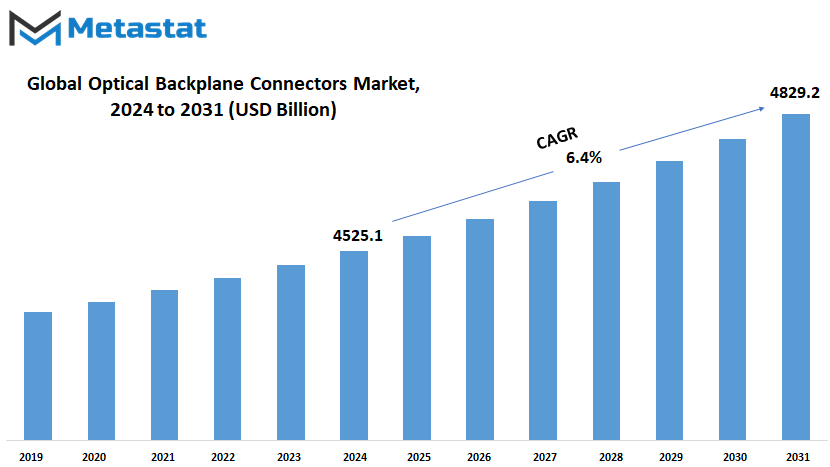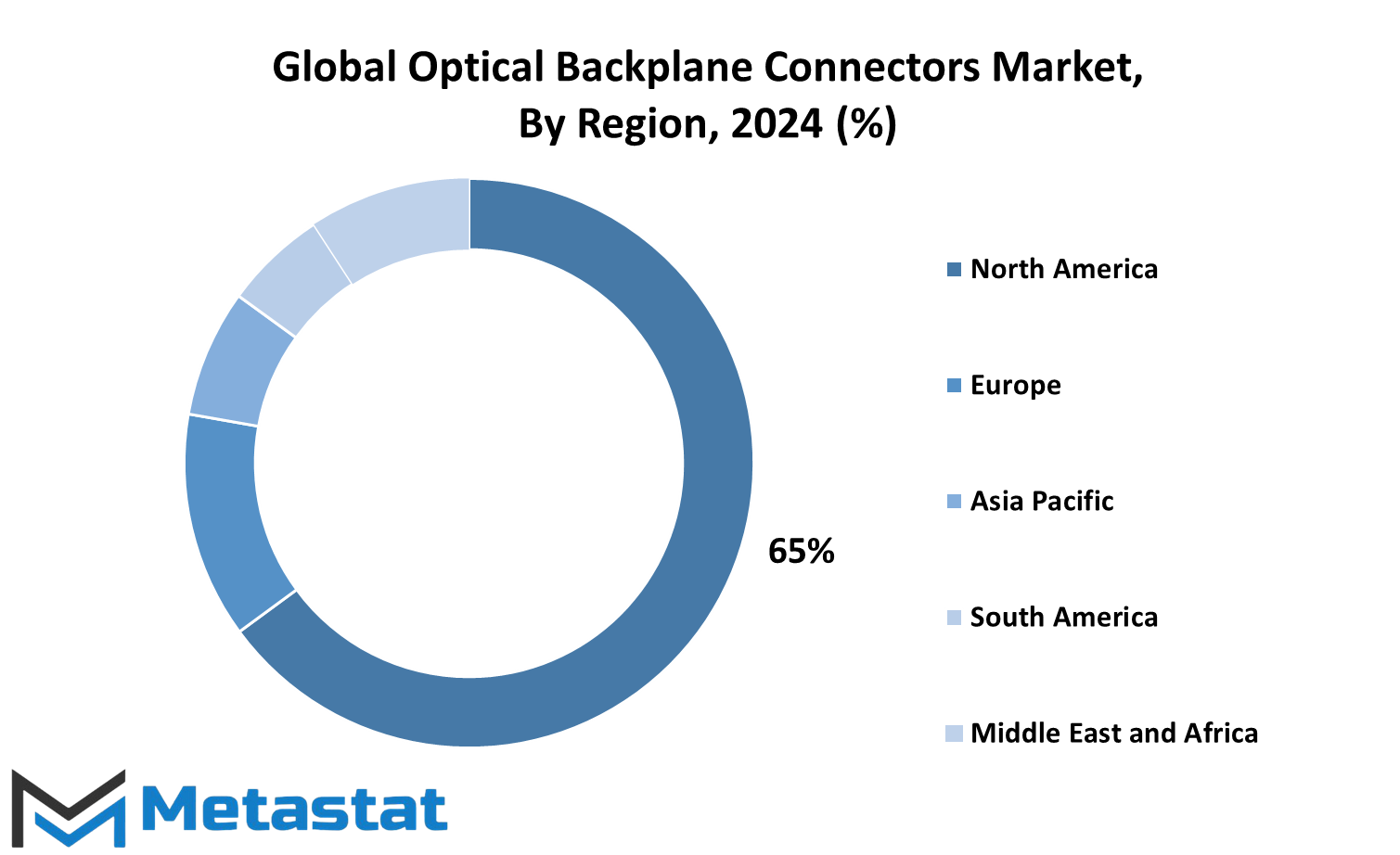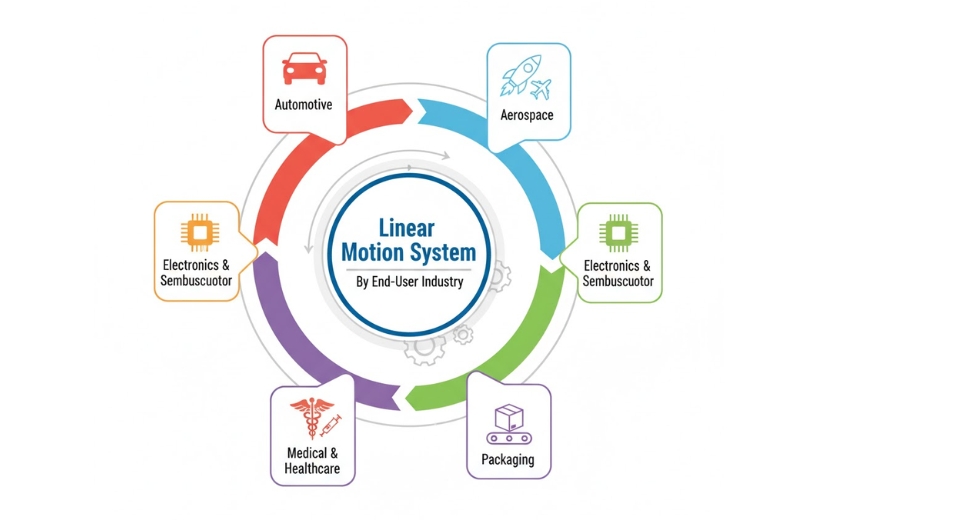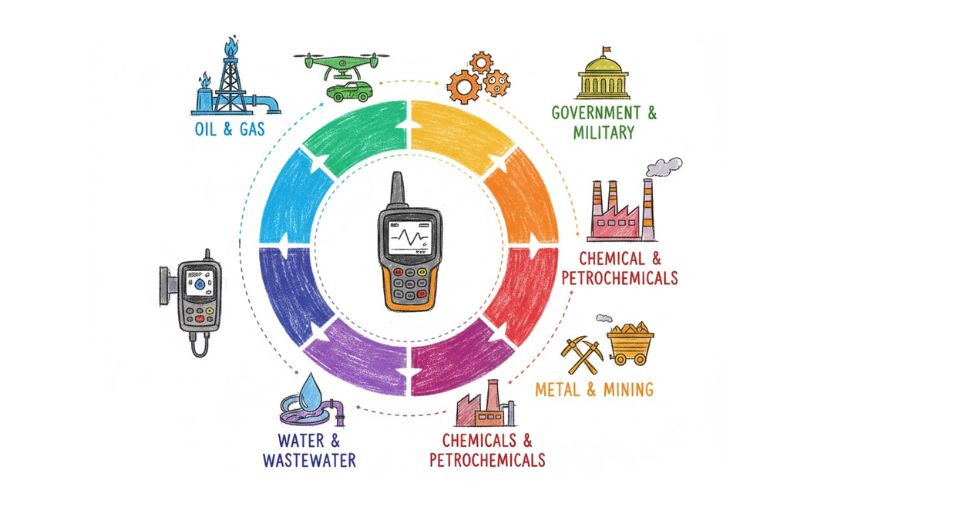MARKET OVERVIEW
The Global Optical Backplane Connectors market therefore has much to go a long way in ensuring that the future of high-speed data transmission is well taken care of within any electronic system. Since they ensure different parts of a system are properly linked, data flows efficiently across its components. Optical backplane connectors will find critical applications in many of these industries that are vital to the data center, telecommunication, and industrial automation systems. High-performance computing and communication systems require bandwidths that are faster and more reliable. The use of such connectors will then be propagated.
Optical backplane connectors actually transfer data through light, rather than by electrical signals. This makes it truly much more useful for systems where high data throughput must be passed over distances without degradation. In contrast to typical copper-based connectors, optical connectors generally offer lower latency, signal loss, and a higher energy efficiency. All these benefits make them number one choice in high-performance environments such as server, network switch, and routers, where there is vast data to be processed and communicated.
By this, the Global Optical Backplane Connectors market will spread across a multiple number of sectors, given the growing demand for high-speed and efficient communication networks. The demand for massive volume data centers and the telecommunication system is bound to increase, with the rollout of 5G and the growth of cloud computing. Thus, optical backplane connectors shall be a prime necessity in these systems as they will enable faster and more reliable connectivity. They will also be useful in aerospace, defense, and automotive applications in which reliable, high-speed data transfers are critical in radar, navigation, and advanced driver-assistance systems (ADAS) applications.
Over time, manufacturers will focus on design and functionality improvements for the optical backplane connectors to be developed to meet demanding requirements of modern communication systems. Next in line, the innovation would be in the new, small-sized connectors that will allow even faster data speeds and higher integrity of signal integrity. Over time, the focus on industries would increasingly be on efficiency concerning energy consumption, and with this, optical connectors will gradually take over the copper-based traditional connectors which would consume more and generate more heat.
Increasing trend toward automation and Internet of Things (IoT) is going to shape the future of the Global Optical Backplane Connectors market. With more and more devices being connected than ever before, demands for high-speed, reliable data transmission are on the rise. Therefore, Optical backplane connectors are strategically positioned at the heart of ensuring that system can work together seamlessly. The industries would look for higher bandwidth connectors with a better signal quality and greater durability that can withstand the complex data-intensive operation of the future.
The Global Optical Backplane Connectors market would grow as the industries in the world will look to get faster and more efficient data transmission solutions. The optical backplane connectors will become indispensable for sectors requiring large-scale data processing like telecommunications, data centers, and industrial automation. With ever-evolving technology, these connectors will forever be in an evolution process, offering better performance and reliability to continue to suit the need of a more interconnected world. Their role for shaping the future of high-speed data transmission will be great, and their market potential will continue to grow in the coming years.
Global Optical Backplane Connectors market is estimated to reach $4829.2 Million by 2031; growing at a CAGR of 6.4% from 2024 to 2031.

GROWTH FACTORS
The growth of Global Optical Backplane Connectors Market As there is increased need for faster data transfer speeds and higher bandwidth in the data centers and telecommunications networks, optical backplane connectors are gaining demand. This responds directly to the urgency to enable effective communication with the increasing requirements to communicate efficiently, especially in big infrastructure areas. These connectives provide high-speed and reliable transmission over great distances, and thus are important in modernizing data handling systems. The data centre industry-which already has an enormous volume of information exchange in particular-would stand to gain much from the technology, given that it supports the trend towards high speed networks, as well as ever increasing requirements for data.
Another large stimulus driver is increasing adoption in high-performance computing and aerospace applications. Most leading-edge users require more powerful systems, and optical connectors will provide the faster, more efficient data transfer that copper cannot. Optical backplane connectors will play a key role in enabling these industries to manage increased amounts of data while preserving their high performance and reliability to improve system efficiency and reduce latency.
Even with these advantages, there are some downsides. First is the huge expense of installing an optical backplane connector as opposed to a regular connector. The constituent optical parts, installation, and maintenance are very pricey, which prevents corporations from abandoning old technologies for new, optical ones. Moreover, the integration of optical systems in existing electronic infrastructure may be technically challenging. Most systems today follow the traditional copper-based connectors and alteration of these to include optical connector may call for a redesign of considerable quantities of investment made over time.
Optical communication technology is believed to be a growth driver for the Global Optical Backplane Connectors market in the coming future. These advancements would further enhance performance, reduce cost, and make optical connectors more open to a wide number of industries. Since the optical technology continues to become more efficient and cheap, companies within various sectors including telecommunication, automotive, and more are most likely to use even more optical backplane connectors. This trend opens up attractive commercial opportunities for companies active in the development and deployment of such connectors since the demand for faster, more reliable data transmission can only increase. The market will definitely grow significantly over the next few years as these challenges are addressed and the potential of optical backplane connectors is fully realized.
MARKET SEGMENTATION
By Type
The Global Optical Backplane Connectors market is growing steadily, primarily because of technological developments and the increased use of high-speed data transmission among several industries. In the midst of increasing development among businesses and industries toward digitization and faster communication networks, the demand for these reliable optical backplane connectors is also on the rise. These will be used in big systems, such as data centers, telecom networks, and high-performance computing infrastructures.
Based on type, the Global Optical Backplane Connectors market has been segmented into Single-Mode Optical Connectors and Multi-Mode Optical Connectors. Both are used for different purposes depending on the network or system under application. Single-mode optical connectors use for transmitting information of longer distances as compared to a much wave length with less loss. Multi-mode optical connectors are mainly utilized in short-distance data communication. The most significant benefit of multi-mode optical connectors is that they are cost-effective as compared to other connectors while using the connection inside a local area network and data centers. Two other kinds of connectors provided are Optical Fiber Backplane Connectors and Optical Ribbon Connectors. Each of these connectors is specifically meant for heavy data throughputs and to maintain integrity of the signal over long distances. Optical fiber backplane connectors play a significant role in high-speed networking as they ensure to send out data without significant loss, and optical ribbon connectors provide compact and efficient style for organizing and managing multiple fiber optic cables in high-density environments.
The future demand for advanced optical connection technologies will be spurred by advancing cloud computing and the increasing requirements for 5G and High-definition video streaming worldwide. As dependence on digital infrastructure goes up, these connectors become much more significant in ensuring that communication is smoother across any systems and equipment. Their applications in sectors such as healthcare, automotive, and smart cities will drive the demand for optical backplane connectors that are efficient and scalable. It indicates the market will not only sustain itself but also grow to meet the rising demands of the digital age. The Global Optical Backplane Connectors market is geared toward becoming a continuous growth curve. The need for high speed in the transfer of data along with the emergence of new technologies will increase further innovations in the field of optical connectors, ensuring that industry connections will remain very efficient and dependable.
By Material
The Global Optical Backplane Connectors market is moving with high vigor. The need for faster data transmission capabilities in various industries is the major force behind this growth. These connectors are significant and form the basis of an efficient communication system by linking optical fibers in backplane designs. With new materials surfacing in the market, the global market for optical backplane connectors is on the road to advancement in terms of performance and reliability. The demand for faster and more reliable communication systems in places such as data centers, telecommunications, and high-performance computing would be highly necessary, and therefore, the market will expand further.
One of the dominant factors propelling the growth in the Global Optical Backplane Connectors market is the material used for manufacturing connectors. The break down in the market has further been categorized into optical fiber material type, which goes into three categories: POF – Plastic Optical Fiber, GOF – Glass Optical Fiber, and POF – Polymer Optical Fiber. Each one has its own advantages, use may be application specific as well as the performance requirements of the system.
Plastic optical fiber is highly used due to ease in installation and it is cost effective. They are especially viable for short-distance communication systems, such as those used in consumer electronics or inside data centers. Plastic optical fiber is not very susceptible to bending, and hence is quite suitable for places where space is a binding factor. In the future, Plastic Optical Fiber demand is expected to rise with increasing numbers of industries focusing on low installation cost and improving ease of use in communication systems.
On the other hand, Glass Optical Fiber is also particularly famous due to its high transmission efficiency. It is used especially in telecom and long-haul data networks where the issues are performance and reliability. This is because data transmission needs to increase in speed and the more important thing that can be realized for any high-bandwidth communications networks is the demand for Glass Optical Fiber. In the future, Glass Optical Fiber will surely be at the forefront of applications requiring long-distance communication.
Polymer Optical Fiber, though still less prevalent than Plastic and Glass Optical Fiber, provides an alternative that balances both price and performance. It offers advantages over Plastic Optical Fiber-higher data rates-but is cheaper and easier to manufacture than Glass Optical Fiber. Polymer Optical Fiber could be used extensively in industries where a lot of performance is demanded but without the premium price tied to Glass Optical Fiber.
Technological development of materials continues to be the strong driving forces in the Global Optical Backplane Connectors market for the coming years. Continued R&D and discovery of more efficient, durable, and low-cost optical fibers will ensure high demand of optical backplane connectors; support many industries dependent on high-speed data transmission.
By Connector Type
The Global Optical Backplane Connectors market plays a crucial role in the evolving world of telecommunications and data transmission. Such a market is spurred by the increasing demand for high-speed internet, data centers, and networking equipment. The optical backplane connectors play an important role in establishing an integral part concerning seamless data transfer; it provides high-speed connectivity with efficient communication between different components in network devices.
Looking forward, the Global Optical Backplane Connectors market is expected to further expand because industries would require faster and more reliable networks. One of the main reasons for this growth is the increasing demand for high-bandwidth applications. Market expanding, driven by sectors such as data centers, telecommunications, and cloud computing, where reliable data transfer is very important. Since the technology is advancing further, many companies are spending huge amounts to develop the best optical connectors design and functionality. It is anticipated that this would take the market in the right direction with innovations in the future.
Further market classification is done depending on the type of connector. MT Ferrule Connectors, MPO/MTP Connectors, LC Connectors, SC Connectors, and other types can be there in this list. There are different types of connectors, each with its own pros and suited to different applications. MT Ferrule Connectors are even more reliable and offer much better performance in high-density applications, which makes it very suitable for data centers. MPO/MTP Connectors tend to be more flexible and package multiple fibers in a single connection, thereby making them highly suitable for environments that carry a high density of fibers while maintaining a small footprint.
LC Connectors have nearly universal application in corporate and data center environments. They are useful for applications where space is limited, yet they still provide excellent performance. SC Connectors are also common usage where a strong, stable connection is required. The connectors have a reputation for being strong and thus are often used in applications where high reliability is demanded.
The group of "others" encompasses the multitude of specialized connectors, each designed for specific applications and emerging usages. These are bound to acquire increasing relevance as industries keep on innovating and requiring ever-higher performance and more specialized solutions. Expansion on all sides will give way to even more new types of connectors that will be promoted by enhanced technology and manufacturing efficiencies.
The future of global optical backplane connectors has been seen to be bright on various connectors types, indicating continued growth across the type of connectors. Thus, the great future of industries in terms of demand for higher speed and more efficient data transmission will be determined by optical connectors in regard to their significance in future global communication networks.
By Application
Global Optical Backplane Connectors market is on an upward growth track across the world. These are the needs of high speed data transmission and reliability in many complex systems. As industries expand and evolve further, it will increase manifold with much needed ability to transfer large data amounts rapidly for the optical backplane connectors, especially in environments where ordinary copper connectors will be performing poorly.
Data centers, among other industries, are expected to be the early adopters of optical backplane connectors. This is because data centers handle many pieces of information, and their reliance on robust solutions that keep connectivity perfect in their extended networks is immense. It, therefore, has immense promise in terms of more data traffic handling and network reliability. Growing reliance on cloud services and analytics of big data will undoubtedly require increased usage of high-performance optical backplane connectors in ensuring smooth functioning of such centers.
Optical backplane connectors are becoming an increasingly important part of the telecommunication industry. The need for faster and more efficient systems connectivity will also be triggered by the expansion of 5G networks. Given their greater speed of data transfer compared to copper cables, optical connectors serve as essential resources for meeting the current requirements of the telecommunication infrastructure. While the networks continue their incrementation around the world, it is always going to require these connectors for optimal performance and lower latency in communication systems.
Optical backplane connectors will also be widely utilized by the military and aerospace sectors in the future. These applications need connectors for an environment that is both aggressive and can guarantee data transmission in critical situations. Optical connectors are best suited for these sectors; thus, they offer durability and high-speed performance even under extremely aggressive environmental applications. The growing need for more sophisticated and high-performance connectors will be crucial with advancements in the technology used in these industries.
Going forward, optical backplane connectors will get greater penetration in medical equipment whose systems will increasingly be used for real-time data transmission for monitoring and diagnostics. In this manner, these connectors can sustain the high-speed, high-reliability data transmission needs of medical devices, ensuring health information remains accurate and on time for the latest health updates. With the rising use of increasingly sophisticated medical technology, use of optical connectors to support this growth will become one of its greater essentials.
Optical backplane connectors are increasingly relevant in the industry of industrial automation. Increased complexity among automation systems leads to a high demand for connectors that allow high-speed communication among several machines and control systems. These connectors will ensure that the process in an industrial environment is carried out efficiently with minimal downtime and thus maximizing production.
The demand in the consumer electronics industry for optical connectors is slated to grow with advanced product development, which demands higher data processing to facilitate smart devices and gaming consoles. With such increasing consumer expectations, their demand for faster and better transfer of data also would be up.
Optical backplane connectors will find additional frequent applications within the automotive market. With electric vehicles coming to the forefront, and autonomous driving technologies as well as sophisticated infotainment systems being added to cars of the modern era, the needs of automotive manufacturers will include higher data requirements, necessitating the use of advanced optical connectors.
Overall, the Optical Backplane Connectors Market will boom for all the global applications. The application of connectors in every industrial domain demands to provide high speed, reliability, and durability. With each step of technology advancement, its role and applications in such connectors evolve for necessary implementation to be more vital as they form the infrastructures of tomorrow’s most advanced systems.
|
Report Coverage |
Details |
|
Forecast Period |
2024-2031 |
|
Market Size in 2024 |
$4525.1 million |
|
Market Size by 2031 |
$4829.2 Million |
|
Growth Rate from 2024 to 2031 |
6.4% |
|
Base Year |
2022 |
|
Regions Covered |
North America, Europe, Asia-Pacific Green, South America, Middle East & Africa |
REGIONAL ANALYSIS
Global market for Optical Backplane Connectors is quite significantly growing along with the adoption of advanced technologies in the industry to fulfill some communication and data transfer requirements. Due to geographical and regional differences, this market can be segmented into various regions that have their specific dynamics, challenges, and opportunities. A regional analysis gives a clear indication of how such markets are likely to develop and contribute towards the growth of the sector as a whole.
North America, that is the U.S., Canada, and Mexico; it continues to dominate the global market. The region enjoys a mature technology infrastructure and a steady growth in demand for high-speed data transmission across such markets as communications, data centers, and automotive. Demand in the U.S. remains the most significant due to its environment of continuous innovation in technologies. This rapid development of 5G networks and increasing needs for reliable, high-capacity data connections should further fuel growth for the market in the region.
Europe which incorporates the UK, Germany, France, Italy, and the rest of Europe is on the path to showing marked progress. Demand is driven by advancement of optical connectors in smart cities, industrial automation, and renewable energy projects. Considering the country's robust engineering sector, Germany is one of the major markets for optical connectors. The other two neighboring countries of Germany are the UK and France, which lead the world in data center and telecom infrastructure development. Considering renewable energy sources and electric vehicles, the next years will be closely related to much growth, owing to increased demand for high-performance connectors.
This region will include countries such as India, China, Japan, South Korea, and all other countries in this region, with significant growth from the Asia-Pacific region. That is because the fastest-growing economies exist in this region, and the need for Optical Backplane Connectors is being fired up by rapid digital transformation in this region. China and Japan already lead the regional market in electronics manufacturing, and that know-how is to act as a rapid mover for the region. Gaining momentum are adoption trends of 5G technology and expansion of cloud computing networks in India and South Korea, which will increasingly translate into demand for optical connectors in the near future.
South America, with Brazil and Argentina, will also grow, but probably at a slower pace in the rest of the regions. Improvement of infrastructure there, however, will, gradually push demand for advanced data transmission solutions. The Middle East and Africa are likely to have less market share, but the investments in technology infrastructure through smart cities are on the increase in countries like the UAE and South Africa, and should provide growth opportunities.
The Optical Backplane Connectors market, in all regions, is likely to develop diversely with increasing technological advancements and demand for high-speed, reliable communication systems shaping the demand.

COMPETITIVE PLAYERS
The Global Optical Backplane Connectors market is growing on a rapidly advancing scale. This can be attributed to the increasing need for high-speed data transmission and reliable systems of communication in many sectors. As technology advances, people have increasingly needed efficient connectors capable of handling high-bandwidth applications like data centers, telecommunications, and high-performance computing. This, in turn, has catapulted the competition based on the key players in the industry with constant improvements in the product offerings towards making market entrances fruitful.
The market influence of this market are being dominated by TE Connectivity, Molex, LLC, and Amphenol Corporation that are key market influencers due to a strong global presence and innovation. These players are the leaders in the optical backplane connector product offerings for diverse applications. For instance, TE Connectivity is associated with its extensive portfolio of interconnect solutions, while Molex is recognized for the development of connectors to meet the needs of high-speed networking and telecommunications. While Amphenol Corporation has been devoted to the manufacturing of advanced connectors for applications ranging from aerospace, automotive, and industrial markets.
Major players including Samtec, Inc., Fujitsu, and also Radiall, are also experiencing rapid expansion within the market through their development of high performance connectors that keep living up to an increasingly ramping demand for higher data transmission speeds. For example, advanced optical interconnect solutions by Samtec have been featured in all manner of applications: from cloud computing to telecom networks. Fujitsu too continues to upgrade the nature of its optical connector technology to better meet the changes within data-intensive industries.
Other market leaders are Yamaichi Electronics Co., Ltd., Finisar Corporation, and Siemon. They emphasize providing high-quality connectors that ensure communication takes place in perfect harmony without the loss of data content. Yamaichi Electronics has lines of high-density connectors while Finisar has optical communication products that drive the means of connector development for optical networking. Siemon specializes in reliable networking solutions, which range from optical backplane connectors best suited for high-performance systems.
As demand for faster and more reliable data transmission increases, companies, such as 3M Company, Corning Incorporated, and Delphi Technologies, are at the forefront of innovating into optical connector technology. In light of its strong history in fiber optics, Corning would prominently be part of ensuring that all stakeholders developing the optical backplane connectors have a brighter tomorrow, especially regarding quicker and more reliable communication in both consumer and enterprise applications.
Broadcom Inc., Hirose Electric Co., Ltd., JAE Electronics, Optical Cable Corporation, Panduit Corp., and Belden Inc. are also crucial in the development of the market. They have a wide range of optical interconnect solutions for industries as different as telecommunications to automotive. With this stiff competition, more innovations can be expected from these companies in terms of solutions that may outline the future of the Global Optical Backplane Connectors market.
This has sparked the ever-increasing demand for high-speed, high-capacity communication systems. Thus, the optical backplane connectors market will continue to rise. The listed firms will lead the formation of next-generation connectors that will create the future of technology and communication. Competition in the Global Optical Backplane Connectors market will instead bring about a more evolved product, which meets the need of industries becoming more sophisticated and data-driven.
Optical Backplane Connectors Market Key Segments:
By Type
- Single-Mode Optical Connectors
- Multi-Mode Optical Connectors
- Optical Fiber Backplane Connectors
- Optical Ribbon Connectors
By Material
- Plastic Optical Fiber
- Glass Optical Fiber
- Polymer Optical Fiber
By Connector Type
- MT Ferrule Connector
- MPO/MTP Connectors
- LC Connectors
- SC Connectors
- Others
By Application
- Data Centers
- Telecommunications
- Military & Aerospace
- Medical Equipment
- Industrial Automation
- Consumer Electronics
- Automotive
Key Global Optical Backplane Connectors Industry Players
- TE Connectivity
- Molex, LLC
- Amphenol Corporation
- Samtec, Inc.
- Fujitsu
- Radiall
- Yamaichi Electronics Co., Ltd.
- Finisar Corporation
- Siemon
- 3M Company
- Corning Incorporated
- Delphi Technologies
- Broadcom Inc.
- Hirose Electric Co., Ltd.
- JAE Electronics
WHAT REPORT PROVIDES
- Full in-depth analysis of the parent Industry
- Important changes in market and its dynamics
- Segmentation details of the market
- Former, on-going, and projected market analysis in terms of volume and value
- Assessment of niche industry developments
- Market share analysis
- Key strategies of major players
- Emerging segments and regional growth potential







 US: +1 3023308252
US: +1 3023308252






